Scotland's Islands & Highlands Tour Diary
Day 10 : Touring around the Isle
of Lewis
|
|
Tour leader David at the Callanish Stones |
Up to the northwestern tip of the Hebrides, and then
plunging back in time to mysterious pre-history, all on the
remote Isle of Lewis.
Part
of an 11 day/page trip diary - click the links on the right
hand side for the other days in this diary. |
Jeanette and her husband Ken
were on our 2010 Scotland's Islands and Highlands Tour, and
Jeanette kept a detailed day by day diary of the tour.
She has very graciously allowed
it to be re-published here, so as to allow you an unvarnished
view into what the tour was all about.
The text is hers, which I've
respected and not changed apart from a few subheadings and extra paragraph
breaks and some Americanizations of her English spelling (they
are from New Zealand).
I've sourced the pictures and
their captions are also from me, not Jeanette.
You can follow along with her
narration by tracking the tour on this
tour
itinerary page and the linked Google maps.
I hope this will encourage you
to come on our
2011 Scotland's Islands and Highlands Tour.
Day 10 – Monday June 23rd
2010 – Stornaway (Isle of Lewis)
Google Touring Map for the Day
I had a very restless night
as I woke up nearly every 2 hours and kept Ken awake with my
snoring. It is very hard to breath with a sinus infection. I got
up at 7am to shower and wash my hair so I felt better after
that. I still do not have much energy but my voice is much
stronger today.
Breakfast at 8:30am with Ken enjoying a full
Scottish breakfast again while I enjoyed scrambled egg with
smoked salmon and mushrooms. It was very showery all morning but
we hoped it would clear by the afternoon.
|
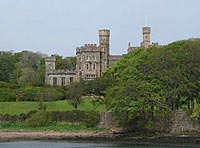
Lews Castle, Stornoway; currently empty but possibly
to become a combination of a museum and a hotel in the
future. |
We were on the bus at 9:45am
ready for our day's outing on the Isle of Lewis. Opposite our
hotel we could see Lews Castle which was built between 1847 and
1857 as a country house for Sir James Matheson who had bought
the whole island a few years previously with his fortune from
the Chinese Opium trade.
The following owner - Lord
Lever of Unilever - gifted the castle
to the people of Stornoway parish in 1923. During World War II
the Castle was taken over as a Naval Hospital referred to as HMS
Mentor. It was used for accommodation for college students in
the 1950s but has been unoccupied since 1987. Today the building
is owned by the local council and is a Category A listed
building.
The island is still very
religious so everything is closed on Sunday. Only as recent as
2009 the island council allowed a Sunday sailing of the ferry.
As we traveled north, we drove onto a high plateau of peat and
heather, with no trees at all. We were heading for the Port of
Ness, the most northern point in the islands. 90% of the people
in Ness and the surrounding area speak Gaelic as their first
language. When we arrived in the town the port was completely
devoid of water as the tide was at its lowest point and 2 boats
were sitting on the sandy bottom.
|
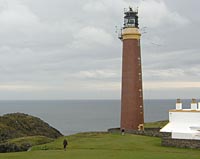
The lighthouse at the Butt of Lewis. |
We then drove along a single
lane road to the Butt of Lewis which is in the Guinness World
Records as the windiest place in the UK. We arrived at the
lighthouse about 10:45am to find another coach already there.
Those who ventured out had to put on their wet weather gear to
visit the lighthouse while I stayed in the warmth of the bus
which Jay positioned so we could see the lighthouse.
The light
was fueled with paraffin until it was converted to electricity
in 1976. It has been automatic since the 1980's and can be seen
for more than 30 miles. When we were all back on the bus, Jane
told Ken she could see a large black owl on the upper balcony of
the lighthouse but after looking through the binoculars he
decided it was a decoy to scare away other birds. We all had a
good laugh at being nearly taken in.
|
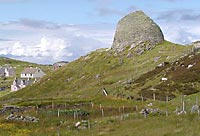
The Dun Carloway broch |
We were away again about
11am, traveling down the west coast for about an hour to visit
Dun Carloway Broch visitor centre. The stalwarts of our group
braved the weather to climb to the broch while the rest of us
took refuge in the visitor's centre. They had a very interesting
display showing how people lived in these circular stone
multi-story brochs, over 2000 years ago.
A short drive to the north
brought us to the most interesting Gearrannan Blackhouse
Village, on the wild Atlantic coast. People have been living
here for well over 300 years but in 1974 the last residents
left, leaving the village to degenerate into ghostly ruins.
|
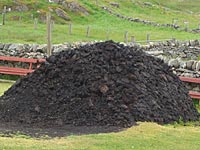
A pile of peat at the Gearrannan Blackhouse Village,
used to fuel the open fires in the cottages. |
During the 1980's a trust was formed to rebuild the houses, set
up a museum and make some available as self catering cottages.
As the cottages are very small, our party was split into 2
groups with our group walking around the village before having
lunch in the cafe.
There are 9 buildings in the village, 4 are
self catering cottages, 1 is a youth hostel, 1 used for public
toilets (very modern), 1 is used as an interpretive centre
showing a very good DVD explaining Harris Tweed weaving and peat
cutting.
The last 2 buildings are being used for the museum
showing live demos of weaving and the recreated inside of a
croft as at 1955, and the cafeteria with a shop. For lunch we
each enjoyed a steaming hot bowl of pea soup and a hot chocolate
(£10.50).
|
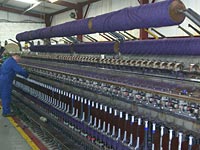
One of the machines at the tweed mill. |
At 2:10pm we had another
short drive to the Harris Tweed factory. We had an excellent
tour, led by staff member Karen, through the whole process. They
take the white cheviot wool and first wash it then dye it, to a
specified pattern, before adding oil back into the wool. The
wool then passes through a carder machine before being spun onto
large rollers. It is then sent to a home weaver.
When the woven
material is returned it is checked by a darner to correct any
breaks and to replace any pieces of wool that are extra bulky by
a thinner piece of the same wool. It is then washed and dried
again before being cleaned of extra fluff and then rolled,
checked and stamped ready for distribution to the world's
markets.
The factory owner, Ann McCullum, had made a beautiful
white wedding dress from undyed Harris Tweed. They showed us a
photo of this most elegant long dress and train.
|
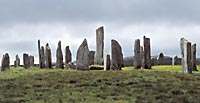
The Callanish Standing Stones. |
About 3:20pm we were on our
way again for another short drive to visit the Callanish
Standing Stones. By mid afternoon the sun had come out and the
rain had stopped. Ken went up to the exposed field containing
the stones while I went into the visitor centre. The 13 primary
stones form a circle about 13m (43ft) in diameter, with a long
approach avenue of stones to the north, and shorter rows of
stones to the east, south, and west. The overall layout of the
monument is similar to a distorted Celtic Cross. The individual
stones vary from around 1m to 5m (3ft to 16ft) in height, and
are of the local stone from the island. We were all back on the
bus shortly after 4pm for the short drive back to Stornoway.
Once back at the hotel, we
took a quick walk to the local Tweed shop where a fascinating
owner went to a lot of effort to tell us how to get to the
museum before it closed at 5:30pm. His shop was a rabbit warren
of tweed cloths and ancient paraphernalia, all very dusty. We
did not stay long before returning to our room (no museum
visit). I showered and had a rest while Ken went out to Tesco
Supermarket to get me another packet of Strepsils. My cough is
not good but my throat seems a lot better.
At 7pm we went down to the
Boatshed Restaurant for dinner with the whole group. There were
23 of us plus David, our guide, and Jay, our driver. Ken had a
starter of oven backed stuffed haggis and black pudding in
crispy puff pastry with a poached egg, spring onions, dauphinoise potatoes and chive gravy. I started with fresh local
Loch Leurbost Mussels cooked in white wine, shallots, garlic,
flat parsley and cream. For the main course, Ken had pan roasted
fillet of Ayrshire pork wrapped in bacon on a bed of sage, onion
and mince pork stuffing with sweet potato puree, cinnamon
flavored apple compote and ruby port jus. I had Lewis salmon
fillet and hand-dived scallops with braised leek and bouquet
garni with a mussel bouillon. Unfortunately our table of 13 was
served quite a long time after the other table of 10 so they
were finished their main course before ours had been served.
|
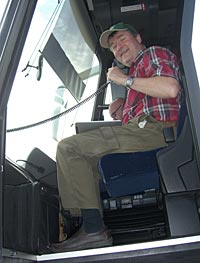
David with one of his iPads balanced precariously on
his knee, driver Jay slightly visible in the background. |
David gave an interesting
speech summarizing our journey together – 11 ferry crossings to
8 islands, we stayed in 8 hotels in 12 days and covered 1300
miles with 23 people and a bike (Oren's).
Jay (our Scottish
driver) told us that this was a very unusual tour visiting
places most tourists never get to see. He enjoyed our company
but will be pleased to see David's Sat Nav disappear (too many
single lane roads).
David used 2 iPad's to help him navigate our
route and to give him important facts and interesting details to
relate to us.
As most people were saying
good night, Ken and Oren were enjoying dessert – Ken had Baileys
and caramel crème brulee with a chocolate glaze while Oren had
old fashioned apple pie with orange sorbet and amoretto custard.
They had a great time discussing investing on stocks, shares and
commodities as well as books to read on Statistics and
Mathematics for the layman.
I left them chatting and went to our
room to finish packing and ring Mum before, hopefully, getting
an early night. We had a 6:30am ferry to catch in the morning.
On my way up to the room I saw some seals in the harbour, just
their heads bobbing in the water. They come in to this harbour,
to feed, every night about 8pm.
Read more in the rest of
Jeanette's Diary
See the links to each day
of the eleven day tour/trip diary at the top
right of this page.
|
If so, please donate to keep the website free and fund the addition of more articles like this. Any help is most appreciated - simply click below to securely send a contribution through a credit card and Paypal.
|
Originally published
7 Jan 2011, last update
30 May 2021
You may freely reproduce or distribute this article for noncommercial purposes as long as you give credit to me as original writer.
|

